Doomsday clock approaches midnight
The inverted yield curve on US Treasuries spells trouble for investors. Alex Rankine reports.

"The nearest thing the global economyhas to a doomsday clock" has "ticked a little closer to midnight," saysRobin Wigglesworth in the Financial Times. Last week the US yield curve which plots the interest rates on Treasury bonds of different maturities inverted for the first time since the summer of 2007. That means that the US government briefly had to pay less to borrow money for ten years than for two years.
An inverted yield curve has preceded every one of America's last seven recessions, which typically follow within 24 months of inversion. In effect, it shows that investors think that short-term interest rates are too high and that a downturn will force the Federal Reserve to cut them.
Americans are still spending
Somebody forgot to tell American consumers about the "imminent recession", says Justin Lahart in The Wall Street Journal. Retail sales rose 0.7% in July on the month before, easily beating predictions. Latest results from retailer Walmart also suggest that the almightyUS shopper should continue to prop up global demand.
MoneyWeek
Subscribe to MoneyWeek today and get your first six magazine issues absolutely FREE

Sign up to Money Morning
Don't miss the latest investment and personal finances news, market analysis, plus money-saving tips with our free twice-daily newsletter
Don't miss the latest investment and personal finances news, market analysis, plus money-saving tips with our free twice-daily newsletter
That is because "inverted yield curves have no predictive significance at all", says Anatole Kaletsky for Gavekal Research. Seven recessions is too small a sample to draw firm conclusions. There have also been two "false positives" the last in 1998 when no recession followed inversion. Internationally, moreover, the phenomenon means little: Britain and Australia have both repeatedly seen yields switch around over the past three decades, even in periods of strong growth.Easy money and global demographicsare driving the bond market, not the economic outlook.
A rational panic?
Surging bond and gold prices showthat "we are in a panic" already, says Charles Gave of Gavekal Research. But barring a resolution of the US-China trade dispute there is no clear way out of the current impasse. Investors should keep a clear head and hedge equity risk withgold rather than bonds. A move intohigh-quality stocks would also be wise.
Get the latest financial news, insights and expert analysis from our award-winning MoneyWeek team, to help you understand what really matters when it comes to your finances.
Alex is an investment writer who has been contributing to MoneyWeek since 2015. He has been the magazine’s markets editor since 2019.
Alex has a passion for demystifying the often arcane world of finance for a general readership. While financial media tends to focus compulsively on the latest trend, the best opportunities can lie forgotten elsewhere.
He is especially interested in European equities – where his fluent French helps him to cover the continent’s largest bourse – and emerging markets, where his experience living in Beijing, and conversational Chinese, prove useful.
Hailing from Leeds, he studied Philosophy, Politics and Economics at the University of Oxford. He also holds a Master of Public Health from the University of Manchester.
-
 Household savings ratio drops – are you setting enough aside for 2026?
Household savings ratio drops – are you setting enough aside for 2026?High inflation has pushed the savings ratio down again and the figure could dip further next year
-
 US stocks: opt for resilience, growth and value
US stocks: opt for resilience, growth and valueOpinion Julian Wheeler, partner and US equity specialist, Shard Capital, highlights three US stocks where he would put his money